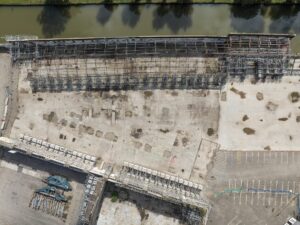History
The Silverthorne Lane site has a rich industrial history dating back to the 18th century. Construction of the Floating Harbour and Feeder Canal began in 1804 and spurred further industrial development in the area. By 1820, a gas works opened on Silverthorne Lane, followed by an iron works in 1828 (later known as the Bristol Iron Works). These two industries became dominant, eventually acquiring most of the land on the lane, producing essential materials for the growing city, like iron products and coal tar derivatives. It’s fair to say that the site was a crucial industrial hub that played a significant role in Bristol’s development.
New Development
This historic industrial area is now set to become a thriving canal-side community
The aims of the re-development project are to:
Project Overview
This project posed several challenges which required careful planning prior to commencing on site including the canal bordering the southern boundary, party wall negotiations and façade retention where some of the walls on a number of the structures were to be retained.

Weaver Demolition began by removing both licensed and non-licensed asbestos throughout the site. Demolition works were then carried out in planned stages. In areas with a façade retention a combination of hand and mechanical methods were used to demolish sections of the structures.
All materials were segregated on site and disposed of to licensed recycling/landfill facilities. Hardcore was crushed to 6F2 specification and retained on site for future use.
Project Requirements
In summary, Weaver Demolition’s key responsibilities during the project were:

Environment Impact
The site was surrounded by both residential and commercial properties, therefore care had to be taken to ensure careful monitoring of dust arising from the works with a dust canon/motofog unit used for dampening down. Approximately 3000 HGV vehicle movements were eliminated by way of reuse and recycling on site.
All timber arisings were recycled off site and reprocessed for the manufacture of kitchen furniture.
Noise levels we kept to a minimum through the use of modern plant and machinery. Anything not in use was switched off to prevent unnecessary noise and pollution from machine idling.
Working directly adjacent to the river, consideration also had to be given to the demolition methods used to ensure no contaminants or waste arisings from the works entered the water.
Key Benefits to the Client

Project Summary
Overall, the Silverthorne Lane redevelopment project was a complex project with various stakeholders involved. The project was managed and delivered by Feeder Estates in collaboration with various other companies for specific aspects, and it was therefore critical for Weaver Demolition to work in tandem with other companies, with regular meetings to plan sequencing and any potential overlaps with other contractors.
Fill in the form below with your requirements and your contact details and we will get in touch with you as soon as possible.